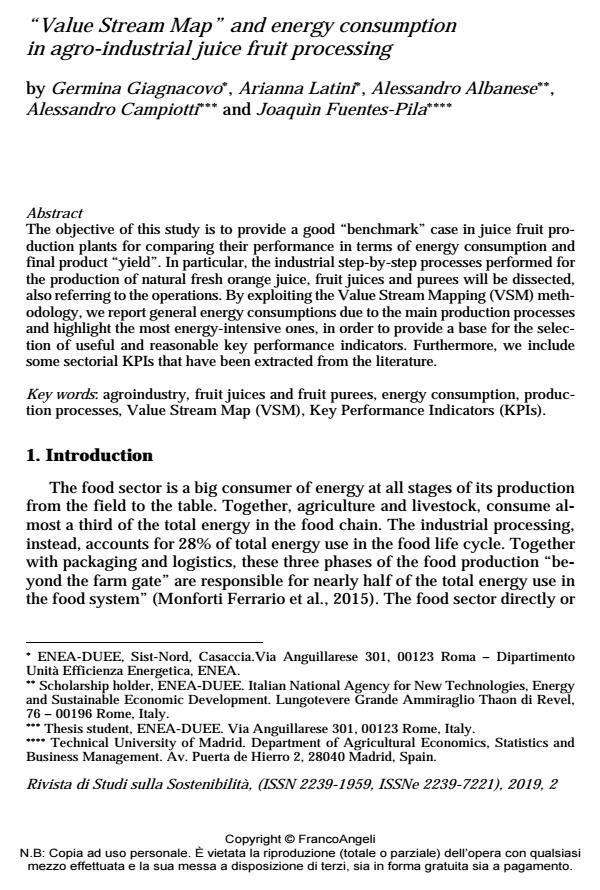"Value Stream Map" and energy consumption in agro-industrial juice fruit processing
Titolo Rivista RIVISTA DI STUDI SULLA SOSTENIBILITA'
Autori/Curatori Germina Giagnacovo, Arianna Latini, Alessandro Albanese, Alessandro Campiotti, Joaquìn Fuentes-Pila
Anno di pubblicazione 2020 Fascicolo 2019/2 Suppl. Lingua Inglese
Numero pagine 16 P. 127-142 Dimensione file 102 KB
DOI 10.3280/RISS2019-002-S1009
Il DOI è il codice a barre della proprietà intellettuale: per saperne di più
clicca qui
Qui sotto puoi vedere in anteprima la prima pagina di questo articolo.
Se questo articolo ti interessa, lo puoi acquistare (e scaricare in formato pdf) seguendo le facili indicazioni per acquistare il download credit. Acquista Download Credits per scaricare questo Articolo in formato PDF

FrancoAngeli è membro della Publishers International Linking Association, Inc (PILA)associazione indipendente e non profit per facilitare (attraverso i servizi tecnologici implementati da CrossRef.org) l’accesso degli studiosi ai contenuti digitali nelle pubblicazioni professionali e scientifiche
The objective of this study is to provide a good "benchmark" case in juice fruit production plants for comparing their performance in terms of energy consumption and final product "yield". In particular, the industrial step-by-step processes performed for the production of natural fresh orange juice, fruit juices and purees will be dissected, also referring to the operations. By exploiting the Value Stream Mapping (VSM) methodology, we report general energy consumptions due to the main production processes and highlight the most energy-intensive ones, in order to provide a base for the selection of useful and reasonable key performance indicators. Furthermore, we include some sectorial KPIs that have been extracted from the literature.
Keywords:Agroindustry, fruit juices and fruit purees, energy consumption, production processes, Value Stream Map (VSM), Key Performance Indicators (KPIs).
- AIJN, European Fruit Juice Association (2016). Liquid Fruit Market Report.
- AIJN, European Fruit Juice Association (2018). Liquid Fluid Market Report.
- Alonso Cabezas I. (2015). Diseño y logística de una línea de elaboración de zumo de naranja natural refrigerado de 20.000l/día. Trabajo fin de grado, Universidad
- Politécnica de Madrid, Departamento de Tecnología de los Alimentos.
- Borgarello M. and Fuso Nerini F. (2011). Analisi dei consumi energetici nei settori industriali. Report Ricerca di Sistema Energetico (RSE).
- De Steur H., Wesana J., Dora M.K. and Gellynck X. (2016). Applying Value Stream Mapping to reduce food losses in supply chains: a systematic review. Waste Management, 58: 359-368.
- Directive 2012/12/EU of the European Parliament and of the Council of 19 April 2012 amending Council Directive 2001/112/EC relating to fruit juices and certain similar products intended for human consumption.
- EU Project SENSE. 7FP HarmoniSed Environmental Sustainability in the European food and drink chain. Deliverable D2.1: Life cycle assessment of orange juice. 2013
- FAO, Food and Agriculture Organization of the United Nations (2005). Codex general standars for fruit juices and nectars (CODEX STAN 247-2005).
- FAO, Food and Agriculture Organization of the United Nations (2011). “Energysmart” food for people and climate. Issue paper.
- Fuentes-Pila J., Garcìa J.L., Benito S., Lopez-Cozar C. and Cede᷉no P. (2017). Electrical Key Performance Indicators (KPIs) Deliverable D2.3 of the EU Project SCOoPE “Saving Cooperative Energy”.
- Jiménez E, Tejeda AS, Pérez M, Blanco J and Martínez E (2012). Applicability of lean production with VSM to the Rioja wine sector. International Journal of Production Research, 50(7): 1890-1904.
- Latini A., Giagnacovo G. and Campiotti C.A. (2017). Thermal Key Performance Indicators (KPIs). Deliverable D2.2 of the EU Project SCOoPE “Saving Cooperative Energy”.
- Latini A., Giagnacovo G., Campiotti A., Bernardini A. and Fuentes-Pila J. (2017).
- Energy analysis and Current Value Stream Map applied to a typical triple concentrate tomato paste production plant with an average production capacity of 500 ton/day. Journal of Agricultural Research, 2(4): 00140. Lozano J.E. (2006). Fruit Manufacturing. Scientific bases, engineering properties, and deteriorative reactions of technological importance. Springer, DOI: 10.1007/978-0-387-30616-2
- Masanet E., Worrel E., Graus W. and Galitsky C. (2008). Energy efficiency improvement and cost saving opportunities for the fruit and vegetable processing industry. An ENERGY STAR Guide for Energy and Plant Manager. -- https://www.energystar.gov/ia/business/industry/Food-Guide.pdf.
- Matche R. S. (2018). Packaging technologies for fruit juices. In: Rajauria G. and Tiwari B.K. (edited by). Fruit juices – extraction, composition, quality and analysis. Elsevier, Chapter 32, pp. 637-666.
- Melvin A. and Baglee D (2008). Value Stream Mapping: a dairy industry prospective. Conference paper,
- Monforti-Ferrario F., Dallemand J.F., Pinedo Pascua I., Motola V., Banja M., Scarlat N., Medarac H., Castellazzi L., Labanca N., Bertoldi P., Pennington D., Goralczyk M., Schau E.M., Saouter E., Sala S., Notarnicola B., Tassielli G. and Renzulli P. (2015). Energy use in the EU food sector: state of play and opportunities for improvement – EU JRC Science and policy report. Edited by Monforti-Ferrario F. and Pinedo Pascua I.
- Northwest Food Processors Association (2010). Energy Intensity Baseline of the Northwest Food Processing Industry.
- Saraceno L., Trinchieri R., Calabrese N., Pieve M., Boccardi G. and Lattanzi A. (2014). Utilizzo di una pompa di calore reversibile a CO2 per la pastorizzazione e la conservazione di miscele per il gelato. EAI – Energia, Ambiente e Innovazione, 4: 39-49.
- Zokaei K., Lovins H., Wood A. and Hines P. (2013). Creating a Lean and Green Business System: techniques for improving profits and sustainability. CRC Press, Taylor & Francis Group.
- Waheed M.A., Jekayinfa S.O., Ojediran J.O. and Imeokparia O.E. (2008). Energetic analysis of fruit juice processing operations in Nigeria. Energy, 33: 35-45.
- Wang L. (2008). Energy efficiency and management in food processing facilities. CRC Press, Taylor and Francis Group.
- Xiao H.W., Pan Z., Deng L.Z., El-Mashad H.M., Yang X.H., Mujumdar A.S., Gao Z.J. and Zhiang Q. (2017). Recent developments and trends in thermal blanching – A comprehensive review. Information Processing in Agriculture, 4: 101-127.
Germina Giagnacovo, Arianna Latini, Alessandro Albanese, Alessandro Campiotti, Joaquìn Fuentes-Pila, "Value Stream Map" and energy consumption in agro-industrial juice fruit processing in "RIVISTA DI STUDI SULLA SOSTENIBILITA'" 2 Suppl./2019, pp 127-142, DOI: 10.3280/RISS2019-002-S1009